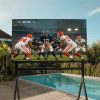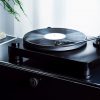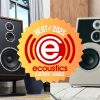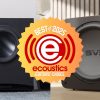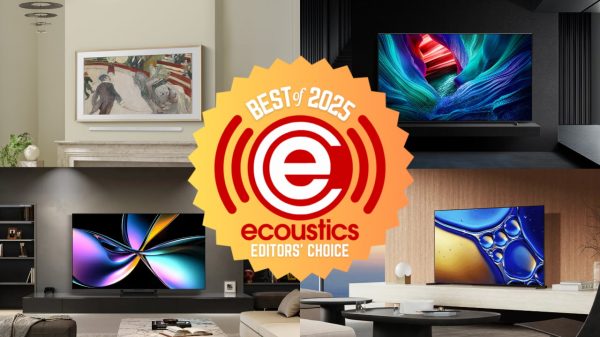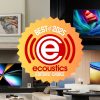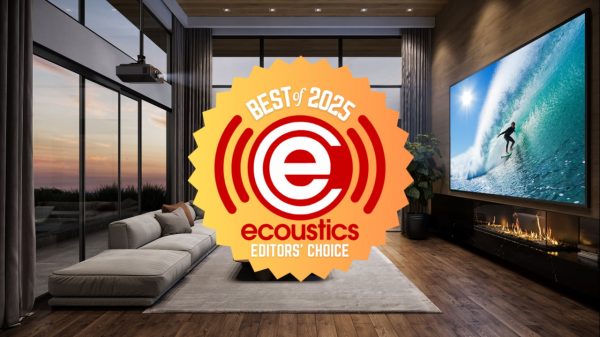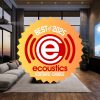At Sony’s 2024 BRAVIA Launch event earlier this year, we got a sneak peek at some of the company’s newest TVs and home theater audio products. One product that stood out was the Sony BRAVIA Theatre Quad, a four-speaker system designed to be connected to a TV or projector in order to elevate the audio experience at home. We were intrigued by what we heard and brought the system in-house for a full review.
What Is It?
Sony’s BRAVIA Theatre Quad ($2,499) is a self-contained powered wireless speaker system which connects to a TV and provides a vastly upgraded immersive surround sound experience for movies, TV shows and music. It’s similar to a soundbar in that it connects to a TV via a single HDMI cable using ARC (Audio Return Channel) or eARC (enhanced Audio Return Channel) and uses wireless transmission to all four speakers so you won’t have to run speaker wires all over your room. Of course, each speaker does require a power connection in order to make sound and communicate with the small control hub which is the device that actually plugs into the TV.

The BRAVIA Theatre Quad replaces Sony’s HT-A9 speaker system, first introduced in 2021. In fact, the official model number of the Quad system is the HT-A9M2 (HT-A9, Mark II). Like the HT-A9 system, the Quad benefits from the addition of a powered subwoofer. In fact, the Quad system is “IMAX Enhanced Certified” but only if you pair it with one of Sony’s wireless subwoofers. The Quad is compatible with Sony’s SA-SW3 ($349) and SA-SW5 ($599) wireless powered subwoofers. We paired the Quad system with the SA-SW5 subwoofer for the duration of our review. Brief listening of the Quad on its own made it clear that the subwoofer is necessary for enjoyable bass performance.

While the HT-A9 speakers included just two main drivers (woofer and tweeter) in each speaker, the Quad offers a separate tweeter, midrange and woofer in each speaker for extended dynamics and frequency response. Like the HT-A9, the BRAVIA Theatre Quad’s built-in amplifiers are rated at 504 watts of total system power. Also, like the HT-A9, the Quad includes an angled top-firing full-range driver in each speaker for reproducing height effects in Dolby Atmos, DTS:X or Sony 360 Reality Audio immersive surround formats. This makes the Theatre Quad system a 4.0.4 channel system on its own or 4.1.4 with a subwoofer. With the use of Sony 360 Spatial Sound Mapping (360SSM), Sony says the Quad system can emulate a 5.1.4 or even 7.1.4 channel system (more on that later).
Who is it For?
Those who care as much about sound as they do about picture quality when watching movies and TV shows and listening to music are potential customers of the BRAVIA Theatre Quad. Unlike a bulky soundbar which needs to be installed under, over or in front of a TV, the Quad system consists of 4 small roughly square low profile speakers that can be mounted on stands, on a table or bookshelf or directly on the wall. At around $3,000, including the cost of an “optional” subwoofer (trust us – it’s not optional), the system is not inexpensive, but it does have a lot to offer.
The Set-Up
Getting the Sony BRAVIA Theatre Quad up and running is a pretty simple affair. The control hub needs to be plugged into wall power and into your TV’s or projector’s HDMI/ARC or HDMI/eARC port. Sony includes an HDMI cable in the box so you won’t need to run to Best Buy for a cable. The four speakers also require wall power and come with power cables that are around nine feet long. The Quad speakers can be wall-mounted using the included mounting brackets or they can be placed on speaker stands or a credenza, table or bookshelf. The included feet measure 5 inches deep and 10 inches wide. Attaching the feet is a simple affair with two brackets and a mounting base that attach to the bottom of each speaker with two screws.

The Quad speakers can sit on any solid platform-type stand that can accommodate the 5”x10” base. If you want a slimmer/sleeker type of stand, the Sanus BSSU2 includes a rear plate that extends high enough to attach to the Quad speaker’s back mounting screw hole and the built-in cable management allows you to hide the Quad speaker’s power cable in the stand for a clean, discrete look.

Tip: Keep in mind that the Quad speakers have up-firing drivers to reflect height sounds off the ceiling and down to the listeners, so be sure the speakers have a clear path to the ceiling.
The Quad speakers are labeled – Front Left, Front Right, Left Surround and Right Surround – so be sure to put each speaker in the right place. If possible, place the front speakers on either side of the TV or projection screen equidistant from the screen and put the rear speakers behind the main listening position equidistant from the main listening position. If you can’t get the speaker placements perfect, the system can compensate with its built-in level calibration and Sony’s 360 Spatial Sound Mapping (360SSM) feature. If you’re using a Sony SW3 or SW5 subwoofer, be sure that’s also plugged into power and find a convenient place to put it. For best bass performance you might need to experiment with placement a bit. We settled on putting the SW5 subwoofer along the front wall, about 12 inches from the wall, a bit left of center.

To complete set-up, download and install the Sony Bravia Connect app on your Android or Apple phone and run through the procedure to add a new device. This will connect your Quad system to your home network and from there to the internet so you’ll be able to keep the system software updated. It will also allow you to do the system calibration as well as easily tweak system settings from the mobile app. During my review, an update to Quad became available. The Quad control unit flashed “update” and “please wait” and the speakers flashed orange. About 10 minutes later the system was up and running again.

While the Quad is compatible with any TV that has an ARC or eARC HDMI port, there are some features (like “Acoustic Center Sync”) that only work with a Sony TV. Also, when you pair the Quad with a Sony TV, you can access many of the system settings from the TV’s remote and the TV’s Quick Settings menu. We tested the Quad with Sony’s BRAVIA 7 Mini LED TV so we could take full advantage of all the features.
Sony includes a small remote with the Quad system for essential operations including volume, bass level, sound field mode, Voice boost (“Voice Zoom 3”) and input selection. In terms of inputs, there aren’t many. The Quad’s control hub offers an HDMI/eARC port for connection to your TV or projector and a second HDMI port for direct connection of a gaming console, streaming stick or Blu-ray player. That’s it. If you have multiple sources, you’ll need to plug these into your TV or projector and get the sound from all of these devices to the Quad system over that HDMI/eARC cable. The Quad also supports a Bluetooth 5.2 connection from your phone or tablet and is compatible with both Apple AirPlay 2 and Spotify Connect for music listening.

If you do have a Sony TV with the “Acoustic Center Sync” feature then go ahead and plug the included 3.5mm cable between the Quad control hub and the TV’s S-Center input. Once it’s connected, you can use your TV as the center channel speaker, allowing the Quad speakers to focus on the music and effects. And you can experiment with the Acoustic Center Sync feature being on or off with a simple setting in the app so you can decide which you like better.
The final step in set-up is to run the built-in calibration routine to optimize the system for your specific listening room. You do this in the BRAVIA Connect app on your phone. This procedure generates a series of test tones to each speaker and uses the microphone built-into your phone to identify speaker locations and adjust the levels of each speaker. When combined with Sony 360 Spatial Sound Mapping (which is on by default), the system will generate phantom speaker channels all around the room in order to create an immersive dome of sound around the listener. You can toggle the 360SSM processing on and off in the app or by using the Sound Field button on the Quad’s remote control.
Listen Up
The HT-A9 was a popular home theater audio product for Sony and offered solid audio performance, but there were some who experienced audio drop-outs in some situations, likely due to dropped WiFi connectivity. In our few weeks with the BRAVIA Theatre Quad system, we did not experience any audio drop-outs. The system provided reliable, punchy, dynamic sound, regardless of whether it was reproducing the nuanced Dolby Atmos soundtrack of “Dune, Part II,” on UHD Blu-ray Disc, the bombastic IMAX Enhanced/DTS:X soundtrack of “Queen Rock Montreal” from Disney+ or the multi-layered immersive surround of Daft Punk’s “Get Lucky” or Pink’s “Trustfall” remixed and remastered in immersive 360 Reality Audio.
With the Quad speakers placed on stands about 30” off the floor in a room with ceilings a little over seven feet high, the height effects on Dolby Atmos and DTS:X soundtracks came through loud and clear. Helicopters flew overhead. Rain fell from above and the spice-laden sand from Arrakis swirled all around my listening room. If you have higher ceilings or textured ceilings, the quality of your height effects may vary, but in a compatible room, the Quad speakers work well for immersive surround.
When watching movies and TV shows, I tested out the “Acoustic Center Sync” feature using the Sony BRAVIA 7 TV’s built-in speakers for the center channel. This helped to lock the dialog on screen for TV shows and movie viewing but ultimately, music listening was better with the Quad speakers reproducing everything so I left the “Acoustic Center Sync” feature off for most music listening. The timbre of the TV speakers was not a great match to the Quads so objects, voices, vehicles or instruments that moved around the room changed in sonic character when they moved to the TV speaker. The nice thing about Acoustic Center Sync is that it can be enabled or disabled with a simple setting in the Bravia Connect app.

Most of my music listening lately has been in Dolby Atmos and, to a lesser extent, Sony 360 Reality Audio. Thousands of classic catalog tracks and new releases have been mixed and mastered (or remixed and remastered) in Dolby Atmos and 360 Reality Audio surround sound. This creates a more engaging listening experience, in some cases (like Queen “Bohemian Rhapsody” or Ed Sheeran “Shape of You”) by putting the listener into the center of the music with instruments and voices surrounding you, or in other cases (like Pink Floyd live concert recordings) by providing a more realistic representation of a live performance with hall and crowd ambience embedded into the mix.
One of my go-to Dolby Atmos tracks, KX5 and Deadmau5 “Alive” sounded impressive on the BRAVIA Theatre Quad. Electronic instruments and percussion used the entire hemisphere of sound in the Dolby Atmos mix, with perfect tonal matching as sounds moved all around the listening room. And when the bass dropped, the SW5 subwoofer did a great job of slamming my whole body with deep impactful bass. Compared to 5.1.4 and 7.2.4 discrete component speaker systems on a Denon AVR-X3800H receiver, the immersive soundfield wasn’t quite as seamless on the Quad system, but considering the whole Quad system lacks even a single speaker wire, offers a compact and elegant form factor and can be placed in less than perfect positions, the Quad system definitely held its own.
I listened to a lot of music and watched a lot of movies on the Quad system. On the original “Dune” film (2021 version), in the scene where Paul Atreides and his father rescue spice miners from an impending worm attack, the Quad system kept its composure while sand swirled, the score swelled, and Bene Gesserit voices intruded on young Atreides’ thoughts. On episode 1 of “Andor” the rain scene at the very beginning was presented realistically with rain falling convincingly from overhead. When Andor enters the club, the system did an excellent job of keeping the dialog crisp and audible while also playing dance music with throbbing bass in the background.
Overall, the Quad system offered a huge improvement over TV sound. It was capable of reaching impressive volume levels without losing its composure and offered extended low bass which could compete with a good medium-priced wired subwoofer. It also offered an expansive dome of sound on content mixed in Dolby Atmos or DTS:X. The ability to mount the front speakers on either side of the TV enabled a much wider more expansive soundstage than you can get with any soundbar.
Comparison to a Component-Based Home Theater System
During the course of my review, I compared the Quad system to a component-based traditional home theater system comprised of Denon’s AVR-X3800H receiver and the Klipsch Reference Cinema 5.1.4 speaker system. The systems are comparable in that they both include small bookshelf speakers with up-firing drivers for height channel duties and a single powered subwoofer. The MSRP of the component system is close to $3,000 ($100 less than the Sony system) though the receiver is normally discounted up to 20% as were the speakers before the Klipsch system was discontinued.
While the Sony Quad system had slightly more refined treble reproduction, the Denon/Klipsch system was more dynamic and impactful overall. Orchestral music with prominent string sections sounded less strident on the Quad system, while EDM and House music with heavy bass lines were better represented on the component system. Movies and action heavy TV series had a more cinematic and punchy presentation on the component system though the Quad system and subwoofer definitely kept up with the component system on most types of material. Setting up and operating the component system with its speaker wires and complicated remote control presented more of a challenge than the Quad system, but the component system offered a simpler upgrade path as you can upgrade just the speaker system without worrying about replacing the processor and amplifier.
Overall, I’d give the component-based system the win as far as overall sound quality, but the Quad was far easier to setup and more flexible and discreet in its placement options.
A Few Words about Sony 360 Reality Audio
For the most part, the Quad system didn’t require any special set-up, other than plugging in the HDMI cable, plugging the speakers and subwoofer into power outlets and running the calibration routine. But getting Sony’s 360 Reality Audio to work did require some extra effort. On previous Sony soundbars like the HT-A5000 and on Sony’s ES A/V receivers, Sony 360 Reality Audio was supported via Chromecast Built-in (now called “Google Cast”). You would load up a streaming service like TIDAL or Amazon Music Unlimited on your phone, and use Chromecast Built-in to deliver the 360 Reality Audio music track to the speakers. Things are different with the Quad.

If you want to listen to music tracks in Sony’s own immersive audio format (360RA) on the Quad system, you actually need to connect a separate source component to the second HDMI input on the Quad’s control hub. There are few streaming music services that support 360 Reality Audio and even fewer devices that can play it back over an HDMI output. One such device is the FireTV 4K Max streaming stick, which we had on hand for testing. While you can find a decent selection of 360RA music tracks on services such as TIDAL and Amazon Music Unlimited, the only streaming app that could successfully pass a 360RA soundtrack to the Quad from the FireTV stick was Amazon Music Unlimited.
With the FireTV stick connected to the Quad control unit, I loaded up some 360RA playlists from Amazon Music Unlimited and confirmed that I was getting the fully immersive multi-channel mixes. I listened to albums and tracks from Pink, Olivia Rodrigo, Foo Fighters, Pink Floyd and Daft Punk which came through in all their immersive glory. Lead vocals were natural-sounding and locked in the phantom center channel created by Sony’s 360 Spatial Sound Mapping. Instruments, immersive effects and background vocals expanded to fill the entire room from top to bottom, back to front with barely noticeable gaps between each speaker. It did really sound – and feel – like there were more than just four speakers in the room (plus the subwoofer).
Sadly, the future of 360 Reality Audio isn’t bright. With Deezer having ended support for 360 Reality Audio last year, and TIDAL announcing that they are withdrawing support this month, only Amazon Music remains as a major streaming service to support the format. And with the requirement to buy a third party streaming device to support it on the Quad and other Sony speakers, we expect few people will make the effort to enjoy immersive music in 360 Reality Audio format.
Can You Really Put Your Speakers Anywhere?
Sony touts one of the BRAVIA Theatre Quad’s features as the ability to place speakers in non-optimized positions in the room. The Quad, like the BRAVIA Theatre 8 and Theater 9 soundbars, uses Sony’s 360 Spatial Sound Mapping feature to map virtual speaker channels to ideal locations even if you can’t place the physical speakers where they should be. I tested this by placing the right speaker right up next to the TV screen while the left speaker was 4 feet away from the TV, and the rear speakers in equally non-ideal mis-matched locations.

After moving the speakers around, I re-ran the set-up routine to specify that the front right speaker was right next to the TV, and re-ran the calibration routine to optimize the system. I then played back some test tones from a Dolby Atmos test disc on Blu-ray Disc (7.1.4 channels and 9.1.6 channels). While the center channel image created between the two front speakers was positioned squarely in line with the screen, the right front channel didn’t really extend outward from where the physical speaker was placed, and the same was true for the rear channels. I did not hear any virtual “phantom” channels in the “correct” speaker locations when 360SSM was engaged. Even with the speakers placed in more ideal locations, the Quad system could not accurately reproduce a 7.1.4 channel Dolby Atmos test signal. I had expected the Quad system to place a phantom side surround channel between the front and rear channels when fed with a 7.1.4 channel signal, but it did not do that. The system routed both the side surround and rear surround test tones to the rear speakers at comparable volumes with no illusion of different spatial positioning.
So, in my experience with this specific Quad system, 360 Spatial Sound Mapping was not a magic bullet that could perfectly compensate for non-optimal speaker positions. The system sounded better integrated with the original speaker positioning, with each front speaker about four feet from the center of the TV screen and the rear speakers also each around 4 to 5 feet away from and slightly behind the main listening position. In these positions, and with a flat reflective ceiling, the Quad system could produce a cohesive and effective dome of sound all around and above the listener. Your mileage may vary.
Harnessing the Power of the Quad
While the little screen on the Quad hub isn’t very informative, you can get a wealth of information about what audio signal you’re receiving, and what surround mode is engaged in Sony’s BRAVIA Connect mobile app. The app also gives you the ability to adjust the sound to your liking, lowering or raising the levels of the surround speakers and subwoofer, changing which surround mode is active and switching on and off Acoustic Center Sync. As far as soundbar apps go, Sony BRAVIA Connect is one of the best I’ve seen.

When connected to a Sony TV, you can also make many adjustments in the TV’s Quick Settings menu, using the TV remote control. The Quad comes with its own basic remote as well, with access to the features you’re most likely to need: volume adjustment, input switching, direct bass level adjustment, Night mode and Voice boost. Night mode is a standard dynamic range compressor which also reduces bass output so you won’t annoy sleeping family members or neighbors. I found the Voice mode, which uses Sony’s “Voice Zoom 3 feature” to be great at boosting just the dialog in movies and TV shows without any added harshness in upper midrange or lower treble. Whatever AI they’re using in Voice Zoom 3 seems to be pretty effective at isolating voices.
Pros:
- Rich dynamic sound from an all-in-one wireless solution
- Flexible speaker placement options (within reason)
- Easy set-up with simple built-in app-based calibration
Cons:
- Sony 360 Spatial Sound Mapping can’t completely compensate for poor speaker placement
- Requires additional subwoofer purchase for acceptable bass response
- Expensive
The Bottom Line
At around $3,100 MSRP including the SA-SW5 subwoofer, the Sony BRAVIA Theater Quad exceeds the cost of all but the most expensive soundbar-based speaker systems. It’s even more expensive than an entry to midrange component-based 5.1.4-channel home theater system with a receiver and separate speakers, which can offer superior performance at the cost of additional complexity. But if you’re looking for a sleek, stylish audio system that doesn’t sacrifice performance for style and convenience then the BRAVIA Theatre Quad is worth a look (and a listen).
Where to Buy:
- Sony BRAVIA Theatre Quad –
$2,499$2,199 at Amazon, Crutchfield
- Sony SA-SW5 Subwoofer –
$699$499 at Amazon, Crutchfield
Related Reading:




